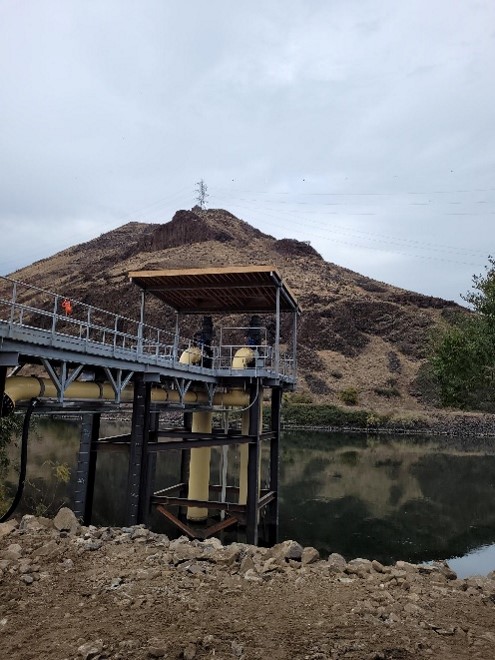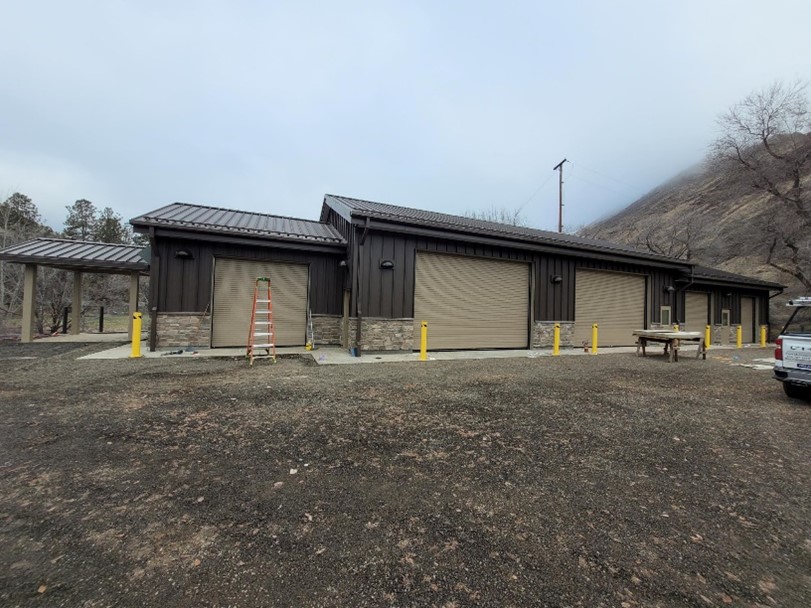Oxbow Fish Hatchery is located in Baker County, Oregon, at the confluence of Pine Creek and the Snake River near the Hells Canyon National Recreation Area. It is situated at the eastern end of Oregon State Highway 86 near the Idaho Power village known as Oxbow. The hatchery is approximately 70 highway miles east of Baker City, Ore., and approximately 150 highway miles northwest of Boise, Idaho.
Oxbow Fish Hatchery is owned and financed by Idaho Power Company, and operated and staffed by the Idaho Department of Fish and Game.
The front access gate is open 8 am to 5 pm mst Mondays through Fridays, excluding major holidays. Access is open to self-guided tours. Interpretive signs and cultural panels are set up for the public. Guided tours for larger groups to walk the raceways or see inside the buildings need scheduled in advance. Please call 208-287-2813 to schedule.

Related Location
55120 Hatchery Drive
Oxbow, OR 97840
United States
Oxbow Fish Hatchery serves as a trapping and spawning facility for steelhead broodstock, and a trapping facility for spring Chinook salmon (for Rapid River Fish Hatchery production). Adult salmon and steelhead are collected at a trap 23 miles downstream from the hatchery at the base of Hells Canyon Dam on the Oregon side of the river.
The hatchery was built in 1961 and was the first hatchery constructed by Idaho Power as part of its mitigation program. Over the course of its history, Oxbow Fish Hatchery has served a variety of functions. Originally, it was used to evaluate the feasibility of rearing Snake River fall Chinook salmon in a hatchery environment and releasing them back to the river to supplement the natural Chinook population. In 1964, Oxbow Fish Hatchery assisted in capturing spring Chinook salmon from the Snake River and transporting them to the newly constructed Rapid River Hatchery for spawning. In 1965, the hatchery was modified to accommodate spawning of both fall Chinook salmon and steelhead broodstock. This expanded Oxbow Fish Hatchery’s role to include the distribution of steelhead eggs to Idaho Power’s Niagara Springs Fish Hatchery. A two-year renovation of the hatchery was completed in 2025. The hatchery is a modern facility that maintains current operations and has the infrastructure to for future program changes.
Water Supply - Adult Operation Water Source
Water for adult hatchery operations is pumped from the Snake River. A pumping platform at the 100-year floodplain elevation is adjacent to the hatchery and holds two 100-horsepower production pumps. Only one pump runs at a time, producing up 17 cubic feet per second of surface water. Water from the production pumps passes through a degassing tower that brings total dissolved gasses to equilibrium before going into the adult holding raceways. Water temperatures range from a winter low of 34° F to a late summer high of 72° F.
Adult Raceways
Six raceways that measure 10’ x 10’ x 100’ hold the steelhead and spring Chinook salmon. Each raceway has an electric crowder and electric gates. Flow, water height, and sprayers keep fish in the raceways at optimum conditions. A roof structure with lights, fans, and fencing benefits both employees and protects fish from predators and direct sunlight.
Spawn and Sort Building
Adjacent to the raceways is a two-story spawn and sort building. Fish can be pushed into a common channel in the raceways and brought up to the second floor of the building via an Electroanesthetic Basket (EA). The EA basket administers a mild electric shock to the fish, calming the fish and allowing for easier handling of the fish. Fish can be put through tubes to raceways or tanker trucks from the sorting area. The first floor of the building is set up with live wells and tables for spawning steelhead.
Water Supply - Incubation Water Source
Two wells provide the water for egg incubation. Together they can provide 600 gallons per minute of pathogen free well water to the incubation room or water chiller. The well water is pumped to the degassing tower to get total dissolved gasses to equilibrium. The water comes out of the wells at a constant 53°F. The air chiller can provide an additional 100-150 gpm of 40°F chilled water to delay development of eggs and consolidate egg shipments to Idaho Power’s Niagara Springs Fish Hatchery
Oxbow Hatchery is owned by Idaho Power Company while daily operations are handled by the Idaho Department of Fish and Game. All funding for this project is provided by Idaho Power as part of its operating license for Brownlee, Oxbow, and Hells Canyon dams on the Snake River. The Federal Energy Regulatory Commission requires Idaho Power to operate this facility to conserve fish runs that were impacted by the construction of the three dam complex. These dams were built without fish passage facilities with the idea that salmon and steelhead would be trapped and trucked around the dams. When this program failed, Idaho Power provided funds to build Oxbow Fish Hatchery.
The Two primary objectives of Oxbow Fish Hatchery are:
- To trap and spawn enough returning adult steelhead to provide 1.3 million eyed eggs. Eggs are transported to Niagara Springs Hatchery and ultimately produce 400,000 pounds of steelhead trout smolts annually.
- To trap sufficient numbers of spring chinook adults to produce 1 million smolts annually.
Steelhead Trout
Oxbow Fish Hatchery traps and spawns enough adult steelhead to provide Idaho Power’s Niagara Springs Fish Hatchery near Wendell, Idaho, with approximately one million eggs annually. A majority of the steelhead broodstock are trapped in late October and November. These fish are kept in raceways at the hatchery over the winter to await spawning the following spring. Another small portion of broodstock is usually collected each spring if river conditions are conducive to operation of the trap. This ensures that fish are collected and spawned from all portions of the run. Steelhead that are trapped but not needed as broodstock are released into sport fisheries or distributed to Native American tribes for ceremonial and subsistence purposes. The number of fish trapped in excess of broodstock needs can be as high as 3,000.
Spawning begins in mid-March and concludes by early May. Approximately 600 fish (male and female) are spawned as broodstock with each female producing around 5,000 eggs. Eggs are incubated at the hatchery until early May and then transferred to Niagara Springs Fish Hatchery. In March of the following year, fish have reached smolt size (approximately 8 inches) and are hauled in tankers to the Snake River where they are released below Hells Canyon Dam to begin their 570-mile migration to the Pacific Ocean.
Spring Chinook Salmon
Hatchery staff operate the trap at Hells Canyon Dam from May through mid-July to collect spring Chinook salmon adults for use as broodstock at Rapid River Fish Hatchery. Their goal is to trap approximately 400 adult salmon to produce one million smolts annually. When spawning begins at Rapid River Fish Hatchery in August, a portion of the eggs collected there are transferred to Oxbow Fish Hatchery for initial incubation. These eggs are incubated for about one month and then shipped back to Rapid River Fish Hatchery to complete incubation and rearing.
Fall Chinook Salmon
From 2000 to 2011, Oxbow Fish Hatchery reared 200,000 fall Chinook salmon for release into the Snake River below Hells Canyon Dam. Currently, Idaho Power contracts with Oregon Department of Fish and Wildlife to rear one million juveniles per year on the Salmon River near Hammer Creek per mitigation requirements. Adults are trapped at Lyons Ferry Hatchery in December and reared at ODFW’s Irrigon Hatchery until May for release. Any incidental fall Chinook trapped below Hells Canyon Dam are released back to the Snake River for natural spawning. The stretch of river between Hells Canyon Dam to the confluence of the Salmon River is reserved for natural fall Chinook adults.
The front access gate is open 8 am to 5 pm mst Mondays through Fridays, excluding major holidays. Access is open to self-guided tours. Interpretive signs and cultural panels are set up for the public. Guided tours for larger groups to walk the raceways or see inside the buildings need scheduled in advance.
https://idfg.idaho.gov/article/oxbow-hatchery-redesigned-future

